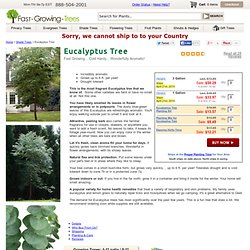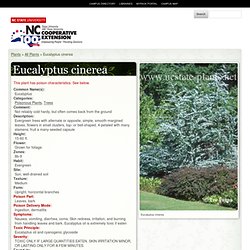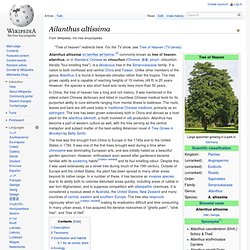

Buxus sempervirens, common box - THE POISON GARDEN website. Summary This evergreen shrub is, generally, thought of as purely decorative but it has an important role in keeping witches from entering the house or, when used as a border, from stealing plants in the garden.

Blog Entries. Picea abies. Picea omorika. ENH-636/ST477: Pinus sylvestris: Scotch Pine. Edward F.

Gilman and Dennis G. Watson2 Introduction. Oskoruša - staro skoro zaboravljeno eko voće. How to identify sorbus aucuparia, Rowan Tree. Sorbus aucuparia, click to enlarge An ideal tree for the medium or large garden.

The Rowan tree takes 40 years to reach 15m (50ft) high and 9m (30ft) in diameter. Rowan or Mountain Ash (sorbus aucuparia)The Rowan tree is native to the majority of Europe (the far south excluded), North Africa and Asia Minor. Because it is such an attractive tree it is planted in all the temperate regions of world in parks, gardens and arboretum. The leaves are shown on the left (click the picture to enlarge). Each stem has around 11 to 15 individual leaves which are toothed along the edges except at the base where they are untoothed.
The bark on young trees is a shiny grey colour ageing to a brown-grey colour. The width of the trunk restricts the size of wood that can be taken form a Rowan. The fruits appear in late summer, and are initially green, they quickly ripen to a bright red in very early September. Each fruit is about 8mm in diameter and they appear in large clusters of 20 or more berries. Sorbus aucuparia 'Edulis' Sorbus domestica - Oskoruša - sadnica (398) - Ukrasno bilje. Oskoruša (Sorbus domestica) Service Tree Sorbus domestica L. Rosaceae Theservice tree grows in North Africa, Asia Minor and southern Europe, as far north as central Germany.

It is sensitive to frost, and requires a mild climate and a fertile, mineral-rich soil to grow well. A slow-growing tree, it reaches a height of 10 to 15 metres, but because it may attain an age of 500 to 600 years one occasionally sees a tree that is 20 metres high. Unlike the mountain ash, the reddish brown bark is longitudinally fissured, even in the young tree. The leaves, odd-pinnate, and grey-downy beneath until midsummer, appear about 14 days later than in the mountain ash. Leaves: 15—18 cm long, odd-pinnate, with 5—9 pairs of lanceolate, serrate leaflets. Sorbus domestica. Acer negundo 'Flamingo' Acer negundo 'Aureo-Variegatum'
Acer palmatum 'Amber Ghost' ('Amber Ghost' Japanese maple. Acer campestre - Javor - sadnica (369) - Ukrasno bilje. Kuglasti bagrem (Robinia pseudoacacia Umbraculifera) Eucalyptus. Some eucalyptus species have attracted attention from horticulturists, global development researchers and environmentalists because of desirable traits such as being fast-growing sources of wood, producing oil that can be used for cleaning and as a natural insecticide, or an ability to be used to drain swamps and thereby reduce the risk of malaria.

Outside their natural ranges, eucalypts are both lauded for their beneficial economic impact on poor populations[5][6]:22 and criticised for being "water-guzzling" aliens,[7] leading to controversy over their total impact.[8] Description[edit] Size and habit[edit] A mature eucalyptus may take the form of a low shrub or a very large tree. There are three main habits and four size categories that species can be divided into. Silver Dollar Eucalyptus Trees & Eucalyptus Plants. Incredibly aromatic Grows up to 6 ft. per year!

Drought tolerant This is the most fragrant Eucalyptus tree that we know of. Eucalyptus cinerea. This plant has poison characteristics.

Ailanthus altissima. Ailanthus altissima /eɪˈlænθəs ælˈtɪsɨmə/,[2] commonly known as tree of heaven, ailanthus, or in Standard Chinese as chouchun (Chinese: 臭椿; pinyin: chòuchūn; literally "foul smelling tree"), is a deciduous tree in the Simaroubaceae family.

It is native to both northeast and central China and Taiwan. Unlike other members of the genus Ailanthus, it is found in temperate climates rather than the tropics. The tree grows rapidly and is capable of reaching heights of 15 metres (49 ft) in 25 years. However, the species is also short lived and rarely lives more than 50 years. The tree was first brought from China to Europe in the 1740s and to the United States in 1784. Description[edit] Botanical drawing of the leaves, flowers and samaras from Britton and Brown's 1913 Illustrated flora of the northern states and Canada. Facts About the Gumball Tree. A mature gumball reaches an average height of 65 to 75 feet, with a maximum height potentially exceeding 100 feet; the average width is between 55 and 60 feet.

Mature bark on the tree's body is brown to gray, while young bark found on stems and new branches is yellow and glossy. Mature bark resembles cork, such as that used in wine bottles. The speed of growth for the tree body is moderate to fast. After the first 5 to 10 years of growth, the tree produces fruit, 1-inch spiked balls, which are green in the spring, hard and brown in the summer to fall.
The leaves are glossy green, and resemble those of a maple tree. Cercis siliquastrum Judas Tree PFAF Plant Database. Freiburger Stadtwald: Experten aus aller Welt begutachten die Freiburger Douglasien. Freiburger Stadtwald: Der Herr über den Traum aller Förster Seite 2/2: Inzwischen ist die Douglasie wieder so sehr in den Fokus von Forstleuten gerückt, dass Freiburg ständig Waldbesuch hat.

Auf unzähligen Fachexkursionen informieren sich Experten aus aller Welt über den Freiburger Waldweg. Denen erklären Burgbacher und seine Mitarbeiter nicht nur, wie man die unteren Äste der Douglasien entfernt, um den dreifachen Ertrag und ein hochwertigeres Holz zu erhalten. "Wir waren zum Beispiel auch die erste Kommune im süddeutschen Raum, die sich speziell nach dem Forest Stewardship Council, dem FSC, hat zertifizieren lassen", sagt Burgbacher. Dass eine derart durchdachte und dadurch aufwendigere Waldbewirtschaftung noch mehr Vorteile bringt, sieht Klaus Wilpert bei seiner Arbeit: Der Leiter der Abteilung Boden und Umwelt bei der Forstlichen Versuchs- und Forschungsanstalt Baden-Württemberg misst ständig Topwerte beim Freiburger Wasser.